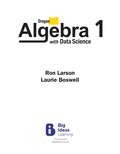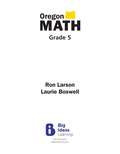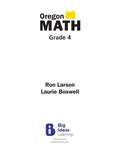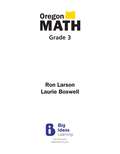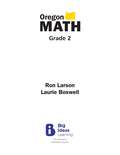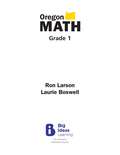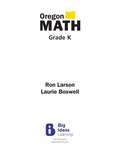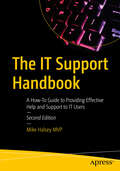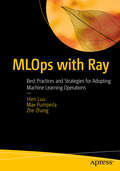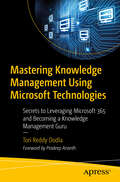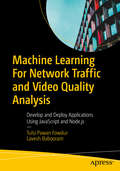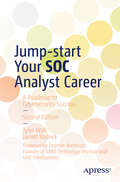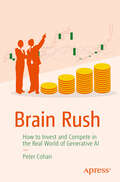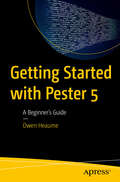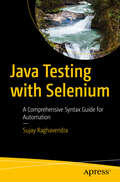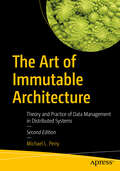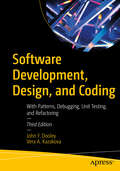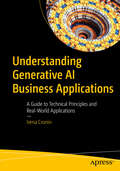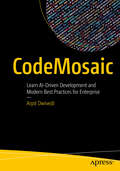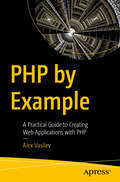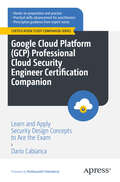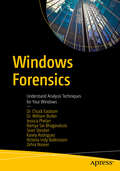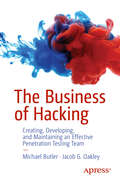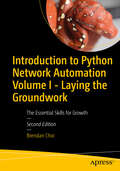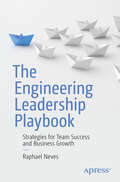- Table View
- List View
Oregon 2024 Algebra 1 with Data Science
by Ron Larson & Laurie BoswellOregon 2024 Algebra 1 with Data Science
The IT Support Handbook: A How-To Guide to Providing Effective Help and Support to IT Users
by Mike HalseyBecome a more effective tech professional by learning how to provide the most useful IT support for your users. You'll learn how to efficiently and effectively deal with any type of problem, including operating systems, software, and hardware. IT support is often complex, time-consuming, and expensive, but it doesn't have to be with the right processes in place. Whether you're an individual, part of an IT support team, or managing staff supporting PC users in their homes, this book will help you understand the right way to approach, troubleshoot, and isolate problems so they can be handled efficiently, with the least disruption and cost to your business. Expanded and revised for this second edition, you'll make yourself popular with your colleagues, and keep your clients and users happy and productive. New To This Edition The world of work has changed, with remote and hybrid working now the new normal and with IT Support departments worldwide having to adapt to this new paradigm. This expanded edition highlights the skills, tools, and structures needed to support businesses of any size in the new normal. What You'll Learn Manage reporting, and keep a record of issues that occur Provide effective remote support for users working from home or elsewhere in the world Use error and system reporting in Windows to obtain high-quality, relevant information Spot patterns in user behavior that may be causing difficult-to-diagnose problems Be familiar with best practices to make you a better support professional Who This Book Is For IT professionals, IT support (on-site and remote), and system administrators who manage support teams. No prior knowledge is required.
MLOps with Ray: Best Practices and Strategies for Adopting Machine Learning Operations
by Max Pumperla Zhe Zhang Hien LuuUnderstand how to use MLOps as an engineering discipline to help with the challenges of bringing machine learning models to production quickly and consistently. This book will help companies worldwide to adopt and incorporate machine learning into their processes and products to improve their competitiveness. The book delves into this engineering discipline's aspects and components and explores best practices and case studies. Adopting MLOps requires a sound strategy, which the book's early chapters cover in detail. The book also discusses the infrastructure and best practices of Feature Engineering, Model Training, Model Serving, and Machine Learning Observability. Ray, the open source project that provides a unified framework and libraries to scale machine learning workload and the Python application, is introduced, and you will see how it fits into the MLOps technical stack. This book is intended for machine learning practitioners, such as machine learning engineers, and data scientists, who wish to help their company by adopting, building maps, and practicing MLOps. What You'll Learn Gain an understanding of the MLOps discipline Know the MLOps technical stack and its components Get familiar with the MLOps adoption strategy Understand feature engineering Who This Book Is For Machine learning practitioners, data scientists, and software engineers who are focusing on building machine learning systems and infrastructure to bring ML models to production
Mastering Knowledge Management Using Microsoft Technologies: Secrets to Leveraging Microsoft 365 and Becoming a Knowledge Management Guru
by Tori Reddy DodlaFor companies and individuals already using Microsoft365 and other Microsoft technologies, this book is designed to reveal how to fully utilize these platforms for effective Knowledge Management without needing to rely on additional third-party tools. It addresses a common issue where organizations find themselves with overlapping technology capabilities for managing knowledge. This situation arises because many companies are not fully aware of the capabilities they already possess within their existing Microsoft tools. Knowledge management firms capitalize on this gap by offering white-labeled, branded applications with user-friendly interfaces, selling them to companies that could achieve the same results with what they already own, if only they knew how to use them properly. By mastering the use of Microsoft technologies for Knowledge Management, organizations can save significant amounts of money that would otherwise be spent on unnecessary external solutions. Whether your objective is to optimize Knowledge Management processes or align these tools with your organization's business processes, this book is designed to serve as a valuable resource, offering practical guidance and strategies to empower your endeavors. By the end of this book, readers will be equipped with the knowledge and skills necessary to make informed decisions regarding the utilization of Microsoft technologies for Knowledge Management and organizational design. What You Will Learn The components of a Microsoft Knowledge Base How PowerPlatfom can support Knowledge Management activities How Microsoft tools fit into the Knowledge Management Landscape How to integrate AI using Microsoft Co-Pilot Who This Book Is For Chief Technology Officers, Chief Information Officers, Chief Knowledge Officers, Chief Digital Officers, Directors of Knowledge Management, Knowledge Managers, SharePoint Administrators, Digital Transformation Consultants
Machine Learning For Network Traffic and Video Quality Analysis: Develop and Deploy Applications Using JavaScript and Node.js
by Tulsi Pawan Fowdur Lavesh BabooramThis book offers both theoretical insights and hands-on experience in understanding and building machine learning-based Network Traffic Monitoring and Analysis (NTMA) and Video Quality Assessment (VQA) applications using JavaScript. JavaScript provides the flexibility to deploy these applications across various devices and web browsers. The book begins by delving into NTMA, explaining fundamental concepts and providing an overview of existing applications and research within this domain. It also goes into the essentials of VQA and offers a survey of the latest developments in VQA algorithms. The book includes a thorough examination of machine learning algorithms that find application in both NTMA and VQA, with a specific emphasis on classification and prediction algorithms such as the Multi-Layer Perceptron and Support Vector Machine. The book also explores the software architecture of the NTMA client-server application. This architecture is meticulously developed using HTML, CSS, Node.js, and JavaScript. Practical aspects of developing the Video Quality Assessment (VQA) model using JavaScript and Java are presented. Lastly, the book provides detailed guidance on implementing a complete system model that seamlessly merges NTMA and VQA into a unified web application, all built upon a client-server paradigm. By the end of the book, you will understand NTMA and VQA concepts and will be able to apply machine learning to both domains and develop and deploy your own NTMA and VQA applications using JavaScript and Node.js. What You Will Learn What are the fundamental concepts, existing applications, and research on NTMA? What are the existing software and current research trends in VQA? Which machine learning algorithms are used in NTMA and VQA? How do you develop NTMA and VQA web-based applications using JavaScript, HTML, and Node.js? Who This Book Is For Software professionals and machine learning engineers involved in the fields of networking and telecommunications
Jump-start Your SOC Analyst Career: A Roadmap to Cybersecurity Success
by Tyler Wall Jarrett RodrickThe frontlines of cybersecurity operations include many unfilled jobs and exciting career opportunities.A transition to a security operations center (SOC) analyst position could be the start of a new path for you. Learn to actively analyze threats, protect your enterprise from harm, and kick-start your road to cybersecurity success with this one-of-a-kind book. Authors Tyler E. Wall and Jarrett W. Rodrick carefully and expertly share real-world insights and practical tips in Jump-start Your SOC Analyst Career. The lessons revealed equip you for interview preparation, tackling day one on the job, and setting long-term development goals.This book highlights personal stories from five SOC professionals at various career levels with keen advice that is immediately applicable to your own journey. The gems of knowledge shared in this book provide you with a notable advantage for entering this dynamic field of work. The recent surplus in demand for SOC analysts makes Jump-start Your SOC Analyst Career a must-have for aspiring tech professionals and long-time veterans alike. Recent industry developments such as using the cloud and security automation are broken down in concise,understandable ways, to name a few. The rapidly changing world of cybersecurity requires innovation and fresh eyes, and this book is your roadmap to success. New to this edition: This revised edition includes three entirely new chapters: Roadmap to Cybersecurity Success, The SOC Analyst Method, and ChatGPT for SOC Analysts. In addition, new material includes a substantially revised Cloud chapter, revised pre-requisite skills, and minor revisions to all chapters to update data. What You Will Learn • Understand the demand for SOC analysts • Know how to find a SOC analyst job fast • Be aware of the people you will interact with as a SOC analyst • Be clear on the prerequisite skills needed to be a SOC analyst and what to study • Be familiar with the day-to-day life of a SOC analyst, including the tools and language used • Discover the rapidly emerging areas of a SOC analyst job: the cloud • and security automation • Explore the career paths of a SOC analyst • Discover background-specific tips for your roadmap to cybersecurity success • Know how to analyze a security event • Know how to apply ChatGPT as a SOC analyst Who This Book Is For Anyone interested in starting a career in cybersecurity: recent graduates, IT professionals transitioning into security, veterans, and those who are self-taught.
Brain Rush: How to Invest and Compete in the Real World of Generative AI
by Peter CohanAfter decades of false starts, artificial intelligence (AI) is entering the mainstream of society. That is largely due to the rapid adoption of ChatGPT, a service that responds to almost any natural language question with cogent paragraphs. ChatGPT is the leading example of generative AI -- technology that creates original text, images, video and computer code based on uncovering patterns in training data. The book will explain how generative AI works and how much economic value it could create and will map out the industry value network. For each value network stage, the book will define the industry, estimate its size, growth rate, and profit potential, identify the most successful participants, and explain how they have achieved their success and where they will compete in the future. The book will conclude with a section on what investors and business leaders should do to make an informed decision on where to place their bets.What You Will LearnInsights on how best to assemble the resources – whether by hiring a consultant or bringing on board a generative AI expert -- to build, train, and operate company specific generative AI applicationsHow management can brainstorm, evaluate and execute the right opportunitiesConcepts and processes to enable investors to place bets with the highest risk-adjusted returnsWho This Book is ForBusiness and enterprises seeking to get value from generative AI, current or potential suppliers of technology and services to companies that build generative AI, and venture capitalists and public equity investors seeking to make profitable bets on generative AI companies
Getting Started with Pester 5: A Beginner's Guide
by Owen HeaumeEmbark on a transformative journey into the world of Pester and elevate your PowerShell scripting to new heights of robustness, reliability, and efficiency. This comprehensive beginner's guide provides a hands-on approach to PowerShell testing using Pester, empowering you to enhance your code quality with confidence.The book starts with an introduction to Pester, the powerful testing and mocking framework for PowerShell. You'll gain a solid foundation by exploring Pester's fundamental building blocks. The book guides you through the phases of Pester, helping you write your initial Pester code. You will dive into topics such as tags, assertions with Should and parameter filters, and you will explore advanced techniques such as Test Drive and Test Registry.You will discover the art of mocking in Pester and master its advanced testing methodologies. You will gain insights into working without installed modules and seamlessly integrating Pester with Azure DevOps Pipeline for a streamlined testing process.After reading this book, you will have the knowledge and skills to initiate your own exploration into PowerShell testing with Pester. You will transform your scripts into reliable powerhouses, ensuring the resilience and quality of your PowerShell code.What Will You LearnBuilding blocks and phases of PesterWriting effective Pester testsAssertions, mocking, and advanced testing techniquesIntegration with Azure DevOpsTags, code coverageWho This Book Is ForPowerShell scripters and Pester Framework beginners
Java Testing with Selenium: A Comprehensive Syntax Guide for Automation
by Sujay RaghavendraMaster the art of automated testing using Selenium with Java in this comprehensive guide. Whether you're a beginner or an experienced tester, the book equips you with the knowledge and techniques to build robust and maintainable test suites, ensuring the quality and reliability of your web applications. This book starts introducing the basics of automated testing and the importance of Selenium. It then covers the setup and configuration of the Selenium WebDriver in Java, providing a solid foundation for your testing environment. You'll learn essential aspects of Selenium testing in Java, including working with different browsers, locating web elements using locators, and performing actions on them. From there, you’ll explore how to handle dynamic web pages and effective wait mechanisms and verifications to ensure accurate and reliable test results. The book also guides you in setting up Selenium in Java for continuous integration and emphasizes best practices for test codeorganization and maintainability, such as the Page Object Model (POM) and structuring test suites effectively. By the end, you’ll have the expertise to address advanced scenarios, such as working with iframes, and know how TestNG enhances Selenium automation, enabling structured tests, data-driven insights, and swift parallel executions. Throughout the book, you'll benefit from real-world examples and practical exercises that reinforce the concepts. The clear explanations and step-by-step guidance make it easy to follow along and apply the knowledge to your own testing projects. What You Will Learn Understand the fundamentals of automated testing and the role of Selenium in web application testing Set up the Selenium WebDriver in Java and configure the testing environment Work with different web browsers and their drivers to perform cross-browser testing Identify and locate web elements using various locators, such as IDs, class names, CSS selectors, and XPath expressions Perform actions on web elements, such as clicking buttons, entering text, submitting forms, and navigating through web pages Handle dynamic pages by implementing effective wait mechanisms, including implicit waits, explicit waits, and fluent waits Verify and assert expected conditions and outcomes using assertions and verification techniques provided by Selenium in Java Apply best practices for test code organization and maintainability, including using the Page Object Model (POM) design pattern Handle advanced scenarios, such as working with iframes, and elevating Selenium automation through TestNG’s structured frameworks, data utilization, and parallel processing Who This Book For Software testers, quality assurance professionals, and developers interested in mastering automated testing with Selenium and Java. Suitable for various experience levels. Offers practical insights and techniques to automate web application testing accurately and reliably. Benefits testers, developers, and individuals familiar with Java and web testing, empowering them to write robust, maintainable test code and integrate Selenium seamlessly into their workflows.
The Art of Immutable Architecture: Theory and Practice of Data Management in Distributed Systems
by Michael L. PerryThis book teaches you how to evaluate a distributed system from the perspective of immutable objects. You will understand the problems in existing designs, know how to make small modifications to correct those problems, and learn to apply the principles of immutable architecture to your tools.Most software components focus on the state of objects. They store the current state of a row in a relational database. They track changes to state over time, making several basic assumptions: there is a single latest version of each object, the state of an object changes sequentially, and a system of record exists.This is a challenge when it comes to building distributed systems. Whether dealing with autonomous microservices or disconnected mobile apps, many of the problems we try to solve come down to synchronizing an ever-changing state between isolated components. Distributed systems would be a lot easier to build if objects could not change.After reading The Art of Immutable Architecture, you will come away with an understanding of the benefits of using immutable objects in your own distributed systems. You will learn a set of rules for identifying and exchanging immutable objects, and see a collection of useful theorems that emerges and ensures that the distributed systems you build are eventually consistent. Using patterns, you will find where the truth converges, see how changes are associative, rather than sequential, and come to feel comfortable understanding that there is no longer a single source of truth. Practical hands-on examples reinforce how to build software using the described patterns, techniques, and tools. By the end of the book, you will possess the language and resources needed to analyze and construct distributed systems with confidence. The assumptions of the past were sufficient for building single-user, single-computer systems. But aswe expand to multiple devices, shared experiences, and cloud computing, they work against us. It is time for a new set of assumptions. Start with immutable objects, and build better distributed systems.What You Will LearnEvaluate a distributed system from the perspective of immutable objects Recognize the problems in existing designs, and make small modifications to correct them Start a new system from scratch, applying patternsApply the principles of immutable architecture to your tools, including SQL databases, message queues, and the network protocols that you already use Discover new tools that natively apply these principles Who This Book Is ForSoftware architects and senior developers. It contains examples in SQL and languages such as JavaScript and C#. Past experience with distributed computing, data modeling, or business analysis is helpful.
Software Development, Design, and Coding: With Patterns, Debugging, Unit Testing, and Refactoring
by John F. Dooley Vera A. KazakovaLearn the principles of good software design and then turn those principles into great code. This book introduces you to software engineering — from the application of engineering principles to the development of software. You'll see how to run a software development project, examine the different phases of a project, and learn how to design and implement programs that solve specific problems. This book is also about code construction — how to write great programs and make them work. This new third edition is revamped to reflect significant changes in the software development landscape with updated design and coding examples and figures. Extreme programming takes a backseat, making way for expanded coverage of the most crucial agile methodologies today: Scrum, Lean Software Development, Kanban, and Dark Scrum. Agile principles are revised to explore further functionalities of requirement gathering. The authors venture beyond imperative and object-oriented languages, exploring the realm of scripting languages in an expanded chapter on Code Construction. The Project Management Essentials chapter has been revamped and expanded to incorporate "SoftAware Development” to discuss the crucial interpersonal nature of joint software creation. Whether you're new to programming or have written hundreds of applications, in this book you'll re-examine what you already do, and you'll investigate ways to improve. Using the Java language, you'll look deeply into coding standards, debugging, unit testing, modularity, and other characteristics of good programs. You Will Learn Modern agile methodologies How to work on and with development teams How to leverage the capabilities of modern computer systems with parallel programming How to work with design patterns to exploit application development best practices How to use modern tools for development, collaboration, and source code controls Who This Book Is For Early career software developers, or upper-level students in software engineering courses
Understanding Generative AI Business Applications: A Guide to Technical Principles and Real-World Applications
by Irena CroninThis guide covers the fundamental technical principles and various business applications of Generative AI for planning, developing, and evaluating AI-driven products. It equips you with the knowledge you need to harness the potential of Generative AI for enhancing business creativity and productivity.The book is organized into three sections: text-based, senses-based, and rationale-based. Each section provides an in-depth exploration of the specific methods and applications of Generative AI. In the text-based section, you will find detailed discussions on designing algorithms to automate and enhance written communication, including insights into the technical aspects of transformer-based Natural Language Processing (NLP) and chatbot architecture, such as GPT-4, Claude 2, Google Bard, and others. The senses-based section offers a glimpse into the algorithms and data structures that underpin visual, auditory, and multisensory experiences, including NeRF, 3D Gaussian Splatting,Stable Diffusion, AR and VR technologies, and more. The rationale-based section illuminates the decision-making capabilities of AI, with a focus on machine learning and data analytics techniques that empower applications such as simulation models, agents, and autonomous systems.In summary, this book serves as a guide for those seeking to navigate the dynamic landscape of Generative AI. Whether you’re a seasoned AI professional or a business leader looking to harness the power of creative automation, these pages offer a roadmap to leverage Generative AI for your organization’s success.What You Will LearnWhat are the technical elements that constitute the makeup of Generative AI products?What are the practical applications of Generative AI?How can algorithms be designed to automate and improve written communication?What are the latest Generative AI architectures and algorithms?Who This Book Is ForData scientists, data analysts, decision makers, and business executives interested in gaining an understanding of Generative AI products
CodeMosaic: Learn AI-Driven Development and Modern Best Practices for Enterprise
by Arpit DwivediThis book is a comprehensive guide for those navigating through the complexities of enterprise software development. For fresh graduates, transitioning from college projects to real-world applications can be overwhelming. This book acts as a roadmap, helping you bridge the gap to become industry-ready. It's like an intensive internship in book form, equipping readers with the skills and knowledge needed for modern tech roles. But it's not just for newcomers. Even experienced developers can get caught up in old routines and miss out on new tools and techniques. With the rise of AI and automation tools like ChatGPT and Copilot, the development landscape is rapidly changing. The core of the book revolves around practical application. Using .NET, Angular, and other Microsoft technologies as foundational pillars, you’ll embark on a hands-on journey. From understanding the basics to designing and deploying a full-stack web application, CodeMosaic offers a holistic learning experience. By the end, you won't just be a developer; you'll be well-equipped to tackle the challenges of today's digital world. What You'll Learn Review Agile methodologies and Azure DevOps for streamlined project management. Gain a thorough understanding of smart development from design to deployment. Master software development with .NET and Angular, along with effective version control using Git. Enhance your coding and design skills using GitHub Copilot, GPT technologies, and AI-driven prompt engineering. Who This Book Is For Experienced developers looking for new tools and techniques, and recent graduates, transitioning from college projects to real-world applications.
PHP by Example: A Practical Guide to Creating Web Applications with PHP
by Alex VasilevLearn to create web applications in PHP with minimal previous experience. This book is a practical guide to using PHP for web development. Loaded with examples and step-by-step instructions, each chapter is dedicated to a specific area or function. You’ll first review the main principles of PHP and what is needed to program and develop in it. You’ll then study variables, data types, control statements, arrays, and functions, all critical for creating efficient PHP programs. The book then moves on to object-oriented programming (OOP) and how to implement those principles in PHP, as well as inheritance, interfaces, testing, error handling, and exceptions. By the end of PHP by Example, you will have the knowledge and confidence to implement PHP for your web projects both large and small. What You’ll Learn Understand PHP from the ground up Create scripts and implement them in real-world projects Work with a broad toolkit of ready-made exercises and solutions Investigate the main constructions of the PHP
Google Cloud Platform: Learn and Apply Security Design Concepts to Ace the Exam (Certification Study Companion Series)
by Dario CabiancaWritten in a simple and developer-focused style, this book gives you the tools and knowledge you need to ace the GCP Professional Cloud Security Engineer certification exam. The approach is two-fold: introducing and implementing all GCP cloud security concepts and controls based on the certification exam objectives, and demonstrating how these concepts can be applied to real-world scenarios. Your study begins with cloud identities in GCP and different identity types (user accounts, service accounts, groups, and domains) and how separation of duties is implemented with access controls and Identity and Access Management (IAM). Emphasis is placed on the unique GCP approach to managing resources, with its clear distinction between resource ownership and resource billing. Following the defense in depth principle, the book shifts focus to network security and introduces different types of constructs that enable micro-segmentation, as they are implemented in a software-defined network. A chapter devoted to data protection is included. You will learn how to leverage the Data Loss Prevention (DLP) application programming interface (API) to prevent access to your workloads’ sensitive data from unauthorized use. Examples on how to use the DLP API are provided using the Go language, which is becoming widely adopted in the developer community due to its simplicity, and high-performance networking and multi-processing capabilities. Encryption at rest, in use, and in transit is covered with an overview on how GCP implements confidential computing. The book concludes with an examination of the GCP services you need to know to monitor, audit, and ensure compliance with the laws and regulations where your workloads and infrastructure operate. By the end of the book, you will have acquired the knowledge and confidence to pass the GCP Professional Cloud Security Engineer certification exam and to successfully design, architect, and engineer security solutions with the Google Cloud Platform. Bonus Material: IAM deny policies What You Will Learn Understand the five security principles and how to use them to drive the development of modern security architectures in Google Cloud Secure identities with Cloud Identity and Identity & Access Management (IAM) Secure the network with segmentation and private connectivity Protect sensitive data with the Data Loss Prevention (DLP) API and encryption Monitor, log, audit, and troubleshoot security incidents with the Google Cloud Operations Suite Ensure compliance and address regulatory concerns Who This Book Is For Software engineers specializing in DevOps, SecOps, and DataOps, who possess expertise in the Software Development Life Cycle (SDLC) methodologies within Agile teams. It also targets software architects with proficiency in various domains such as security, network, solution, data, infrastructure, cloud, and enterprise architecture.
Windows Forensics: Understand Analysis Techniques for Your Windows
by William Butler Chuck Easttom Jessica Phelan Ramya Sai Bhagavatula Sean Steuber Karely Rodriguez Victoria Indy Balkissoon Zehra NaseerThis book is your comprehensive guide to Windows forensics. It covers the process of conducting or performing a forensic investigation of systems that run on Windows operating systems. It also includes analysis of incident response, recovery, and auditing of equipment used in executing any criminal activity.The book covers Windows registry, architecture, and systems as well as forensic techniques, along with coverage of how to write reports, legal standards, and how to testify. It starts with an introduction to Windows followed by forensic concepts and methods of creating forensic images. You will learn Windows file artefacts along with Windows Registry and Windows Memory forensics. And you will learn to work with PowerShell scripting for forensic applications and Windows email forensics. Microsoft Azure and cloud forensics are discussed and you will learn how to extract from the cloud. By the end of the book you will know data-hiding techniques in Windows and learn about volatility and a Windows Registry cheat sheet.What Will You LearnUnderstand Windows architectureRecover deleted files from Windows and the recycle binUse volatility and PassMark volatility workbenchUtilize Windows PowerShell scripting for forensic applicationsWho This Book Is ForWindows administrators, forensics practitioners, and those wanting to enter the field of digital forensics
The Business of Hacking: Creating, Developing, and Maintaining an Effective Penetration Testing Team
by Michael Butler Jacob G. OakleyThere is a plethora of literature on the topic of penetration testing, hacking, and related fields. These books are almost exclusively concerned with the technical execution of penetration testing and occasionally the thought process of the penetration tester themselves. There is little to no literature on the unique challenges presented by creating, developing, and managing a penetration testing team that is both effective and scalable. In addition, there is little to no literature on the subject of developing contractual client relationships, marketing, finding and developing talent, and how to drive penetration test execution to achieve client needs. This book changes all that.The Business of Hacking is a one-of-a-kind book detailing the lessons the authors learned while building penetrating testing teams from the ground up, making them profitable, and constructing management principles that ensure team scalability. You will discover both the challenges you face as you develop your team of offensive security professionals and an understanding of how to overcome them. You will gain an understanding of the client’s requirements, how to meet them, and how to surpass them to provide clients with a uniquely professional experience. The authors have spent combined decades working in various aspects of cybersecurity with a focus on offensive cybersecurity. Their experience spans military, government, and commercial industries with most of that time spent in senior leadership positions. What you’ll learn How to handle and ongoing develop client relationships in a high end industryTeam management and how the offensive security industry comes with its own unique challenges. Experience in other industries does not guarantee success in penetration testing.How to identify, understand, and over-deliver on client expectations.How to staff and develop talent within the team.Marketing opportunities and how to use the pentesting team as a wedge for upsell opportunities.The various structures of services available that they may present to their clients. Who This Book Is For This book is written for anyone curious who is interested in creating a penetration testing team or business. It is also relevant for anyone currently executing such a business and even for those simply participating in the business.
Introduction to Python Network Automation Volume I - Laying the Groundwork: The Essential Skills for Growth
by Brendan ChoiWelcome to Introduction to Python Network Automation Volume I: Laying the Groundwork. In this first part of our comprehensive guide, you'll embark on a transformative journey into the world of network automation. Whether you're new to the IT field or seeking to strengthen your existing skills, this book serves as your roadmap to mastering the foundational skills essential for success in network automation. You'll begin your exploration by delving into the fundamentals of Python network automation, laying a solid foundation for your learning journey. Equipped with essential Python skills, you'll leverage them for network administration tasks, particularly on the Windows platform. Reinforce your understanding through targeted exercises designed to enhance your proficiency and navigate the complexities of VMware Workstation as you master virtualization techniques crucial for setting up your network automation environment. You’ll then venture into Linux fundamentals, learning to set up and configure server environments tailored for network automation tasks while gaining a deep understanding of file systems and TCP/IP services in Linux. Explore the power of regular expressions as you streamline network automation tasks with precision and efficiency. Discover GNS3, a vital tool for network emulation, enabling you to test and validate network designs and put your skills to the test by tackling real-world network challenges in a comprehensive lab scenario. This book provides the essential knowledge and practical experience needed to thrive in the rapidly evolving field of network automation. Whether you're new to network automation or seeking to strengthen your existing skills, this book will unlock the vast potential of network automation and empower you to excel in this exciting field. What You'll Learn Learn Python fundamentals and effective network automation strategies. Use Python for various network administration tasks, improving efficiency. Understand Linux basics and IP service installation techniques. Apply regular expressions in Python for data processing. Create a network automation lab with VMware Workstation for hands-on practice. Who This Book Is For IT engineers and developers, network managers and students, who would like to learn network automation using Python.
The Engineering Leadership Playbook: Strategies for Team Success and Business Growth
by Raphael NevesIn today's business landscape, software engineering teams must deliver innovation faster than ever. However, outdated management approaches centered on tools and metrics rather than people strangle velocity and creativity. Legacy leaders cling to rigid structures mismatched with market dynamics, draining effort and morale from burnt-out teams. The Engineering Leadership Playbook provides a modern framework to unlock your team's potential through empathy, clarity, and empowerment. Unlike traditional leadership books fixated on delivery metrics, Raphael Neves offers a refreshing people-oriented leadership model tailored to nuances of engineering culture. With 15+ years leading high-growth tech teams, Raphael demystifies how to balance autonomy with alignment, reconstruct feedback models on psychological safety, and sustain excellence amidst uncertainty. You'll learn his proven conflict resolution blueprint for defusing clashes through mutual understanding while tangibly tracking progress. Additionally, his continuous feedback system grounded in evidence spotlights gaps early while accelerating strengths. This playbook moves systematically from foundational concepts like emotional intelligence and leading by example into team development frameworks around high-impact coaching, mentorship, and performance reviews. The method is brought full circle through innovation catalysts that maintain creative momentum at scale. Step-by-step, Raphael unpacks human-centered leadership aligned with accelerating market realities. Apply his engineering management playbook, and your teams will thrive fueled by vision, trust, and care. What You'll Learn Study different leadership styles and how to switch their approaches depending on circumstances Review critical communication skills, especially in technical fields Create IDPs for team members, especially senior engineers and leaders Who This Book Is For Current engineering leaders, aspiring engineering leaders, senior engineers, HR professionals and recruiters, and professionals in related fields
